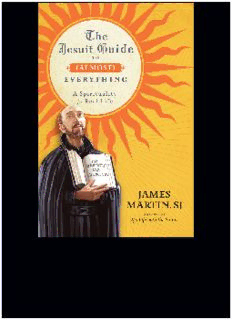
the jesuit guide to (almost) PDF
Preview the jesuit guide to (almost)
T J G HE ESUIT UIDE TO (A ) LMOST E VERYTHING A Spirituality for Real Life J M , S.J. AMES ARTIN 3/485 Contents Cover Title Page Chapter One – A Way of Proceeding Chapter Two – The Six Paths Chapter Three – What Do You Want? Chapter Four – Beautiful Yesterdays Chapter Five – Beginning to Pray Chapter Six – Friendship with God Chapter Seven – God Meets You Where You Are Chapter Eight – The Simple Life Chapter Nine – Like the Angels? Chapter Ten – More by Deeds Than by Words Chapter Eleven – Surrendering to the Future 5/485 Chapter Twelve – What Should I Do? Chapter Thirteen – Be Who You Is! Chapter Fourteen – The Contem- plative in Action Acknowledgments For Further Exploration Index About the Author Praise for The Jesuit Guide to (Al- most) Everything Copyright About the Publisher Chapter One A Way of Proceeding What Is Ignatian Spirituality? WHO ISST.IGNATIUSLoyola, and why should you care? The short answer is this: St. Ignatius Loyola was a sixteenth- centurysoldier-turned-mysticwhofoundedaCatholicreligiousor- dercalledtheSocietyofJesus,alsoknownastheJesuits.Andyou shouldcare(or,morepolitely,you’llbeinterestedtoknowabout him)becausehiswayoflifehashelpedmillionsofpeoplediscover joy, peace, and freedom and, not incidentally, experience God in their daily lives. St.Ignatius’s“wayofproceeding,”touseoneofhisfavoriteex- pressions,hasledpeopletomorefulfillinglivesforover450years. All in all, not a bad record. ThewayofIgnatiusisaboutfindingfreedom:thefreedomtobe- comethepersonyou’remeanttobe,toloveandtoacceptlove,to makegooddecisions,andtoexperiencethebeautyofcreationand themysteryofGod’slove.It’sbasedonanapproachfoundinhis own writings as well as in the traditions, practices, and spiritual know-howpasseddownbyJesuitpriestsandbrothersfromgener- ation to generation. While these traditions, practices, and spiritual know-how have guidedmembersoftheJesuitOrdersinceitsfoundingin1540,Ig- natiuswantedhismethodstobeavailabletoeveryone,notjustJe- suits.FromthefirstdaysofhisOrder,IgnatiusencouragedJesuits 7/485 to share these insights not only with other priests, brothers, and sisters, but also with lay men and women. “Ignatian spirituality” was intended for the widest possible audience of believers and seekers. Maybeit’sgoodtoaskanotherquestionbeforewegoon:whatis a “spirituality”? Inbrief,aspiritualityisawayoflivinginrelationshipwithGod. Within the Christian tradition, all spiritualities, no matter what theirorigins,havethesamefocus—thedesireforunionwithGod, anemphasisonloveandcharity,andabeliefinJesusastheSonof God. But each spirituality emphasizes different aspects of the tradi- tion—one accents the contemplative life, another the active life. This one emphasizes joy, this one freedom, this one awareness, thisonesacrifice,thisoneservicetothepoor.Alltheseemphases are important in every Christian spirituality, but they are high- lighted differently by each spiritual “school.” Practical Jesuits JesuitstaketheircuefromIgnatiusintermsofapractical spirituality.OnejokehasaFranciscan,aDominican,anda Jesuit celebrating Mass together when the lights suddenly gooutinthechurch.TheFranciscanpraisesthechanceto livemoresimply.TheDominicangivesalearnedhomilyon how God brings light to the world. The Jesuit goes to the basement to fix the fuses. InhisbookTheJesuits:TheirSpiritualDoctrineandPractice, firstpublishedin1964,whichIreadduringmyfirstfewweeksasa Jesuit,JosephdeGuibert,aFrenchJesuit,offersacharmingana- logy first made in the Middle Ages. 8/485 Aspiritualityislikeabridge.Everybridgedoesprettymuchthe same thing—gets you from one place to another, sometimes over perilousground,orariver,orgreatheights.Buttheydosoindif- ferent ways. They might be built of rope, wood, bricks, stone or steel;asarches,cantilevers,orsuspensionbridges.“Hence,”writes Father de Guibert, “there will be a series of different types, with eachonehavingitsadvantagesanddisadvantages.Eachtypeisad- aptabletogiventerrainsandcontoursandnottoothers;yeteach one in its own way achieves the common purpose—to provide a passagebymeansofanorganic,balancedcombinationofmateri- als and shapes.” Every spirituality offers you a distinctive “passage” to God. Manyofthemostwell-knownspiritualitiesintheChristiantradi- tion flow from the religious orders: Benedictines, Franciscans, Carmelites,Cistercians.Eachorderhasdeveloped,overthecentur- ies,itsownspiritualtraditions,somedirectlyhandeddownbyits founder,othersthatcomebymeditatingonthelifeandpractices of the founder. Today members of those religious orders live out what Father de Guibert calls a “family tradition.” Spend time with a few Franciscans, for example, and you’ll quicklynoticetheirloveofthepoorandtheenvironment,apas- sion shared by their founder, St. Francis of Assisi. Live for a few daysinaBenedictinecommunity,andyouwillsoontastetheirex- pansive, welcoming spirit, passed down from St. Benedict—not a surpriseforsomeonewhosaid,“Allguestsshouldbewelcomedas Christ.”Religiousorderscallthisthe“charism,”orfoundingspirit, passedonbythefounder.(CharismcomesfromtheLatinwordfor “gift.”) Likewise,spendtimewithaJesuitpriestorbrother,andyouwill begintoexperiencethedistinctivespiritualityofSt.IgnatiusLoy- olaandtheJesuitOrder,whichwe’llsoondescribe.Thesumtotal ofthepractices,methods,emphases,accents,andhighlightsofthe 9/485 Christian way of life that comes to us from Ignatius is known as “Ignatian spirituality.” ThatspiritualityhashelpedtheSocietyofJesusdosomeremark- able things in its colorful history. It’s impossible for me to talk about Jesuit accomplishments without sounding too proud (somethingwe’reaccusedofdaily),soI’lllettheEnglishhistorian JonathanWrightdosoinstead.Thisthumbnailsketchisfromhis marvelousbookGod’sSoldiers:Adventure,Politics,Intrigue,and Power—A History of the Jesuits: They have been urbane courtiers in Paris, Peking, and Prague,tellingkingswhentomarry,whenandhowtogoto war, serving as astronomers to Chinese emperors or as chaplainstoJapanesearmiesinvading Korea.Asmightbe expected, they have dispensed sacraments and homilies, and they have provided educations to men as various as Voltaire, Castro, Hitchcock, and Joyce. But they have also been sheep farmers in Quito, hacienda owners in Mexico, wine growers in Australia, and plantation owners in the antebellumUnitedStates.TheSocietywouldflourishinthe worlds of letters, the arts, music, and science, theorizing aboutdance,disease,andthelawsofelectricityandoptics. Jesuits would grapple with the challenges of Copernicus, Descartes, and Newton, and thirty-five craters on the sur- face of the moon would be named for Jesuit scientists. IntheUnitedStates,Jesuitsareprobablybestknownaseducat- ors, currently running twenty-eight colleges and universities (in- cluding Georgetown, Fordham, Boston College, and every college named Loyola) and dozens of high schools and, more recently, middle schools in the inner city. SinceIgnatiuswantedhisJesuitstobepracticalmenwhocould speaktopeopleclearly,it’snotsurprisingthatovertheyearsJe- suits have boiled down their spirituality into a few easy-to- 10/485 remember phrases. No single definition captures the richness of thetradition,buttogetherthephrasesprovideanintroductionto thewayofIgnatius.Soherearefoursimplewaysofunderstanding Ignatianspirituality.Thinkofthemasthearchesunderthatbridge we talked about. FOURWAYS ThereusedtobeasayingthatJesuittraining wassoregimented thatifyouaskedfiveJesuitsfromaroundtheworldthesameques- tion,youwouldgetthesameanswerfromallfive.ThesedaysJe- suitsareamoreindependentbunch,andyouwouldprobablyget five different answers. Or six. The Italian Jesuits have a saying, “Tre gesuiti, quattro opinioni!”Three Jesuits, four opinions! Butthere’sonequestionthatwouldelicitasimilaranswerfrom thosefivehypotheticalJesuits.IfaskedtodefineIgnatianspiritu- ality,thefirstthingoutoftheirmouthswouldmostlikelybefind- ing God in all things. Thatdeceptivelysimplephrasewasonceconsideredrevolution- ary.Itmeansthatnothingisconsideredoutsidethepurviewofthe spirituallife.Ignatianspiritualityisnotconfinedwithinthewalls of a church. It’s not a spirituality that considers only “religious” topics,likeprayerandsacredtexts,aspartofaperson’sspiritual life. Mostofall,it’snotaspiritualitythatsays,“Well,that—whether it’swork,money,sexuality,depression,sickness—issomethingto avoid when talking about the spiritual life.” Ignatianspiritualityconsiderseverythinganimportantelement of your life. That includes religious services, sacred Scriptures, prayer, and charitable works, to be sure, but it also includes friends,family,work,relationships,sex,suffering,andjoy,aswell as nature, music, and pop culture.
Description: